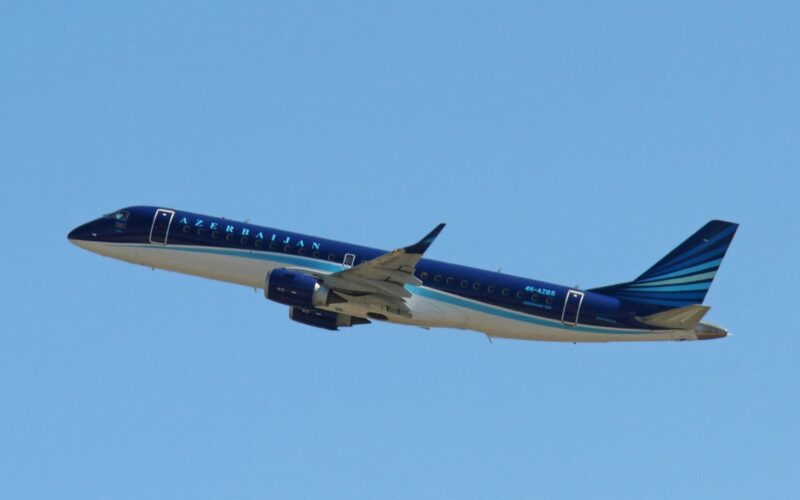The Kremlin confirmed that Russian air defenses were in action on December 25, 2024, when the Embraer 190 aircraft of Azerbaijan Airlines attempted to land in Grozny.
“At that time, Grozny, Mozdok and Vladikavkaz were attacked by Ukrainian combat unmanned aerial vehicles, and Russian air defense systems repelled these attacks,” the Russian presidency wrote in a statement. “Vladimir Putin apologized for the fact that the tragic incident occurred in Russian airspace.”
An Azerbaijan Airlines Embraer E-190 aircraft crashed in western Kazakhstan on December 25, 2024, killing 38 people and leaving 29 survivors.
The aircraft registered 4K-AZ65 carried 62 passengers and five crew members and was conducting flight J28243 from Baku-Heydar Aliyev International Airport (GYD) to Grozny Airport (GRV), Russia.
The flight was reportedly diverted to Uytash Airport (MCX) in Makhachkala, Russia, due to heavy fog in Grozny. According to the flight tracking website Flightradar24, the aircraft was flying at an altitude of approximately 9,144 meters when it disappeared from ADS-B range over the Caspian Sea at 08:40 local time. It reappeared near the coast of Kazakhstan around 10:07 and then began circling the area near the city of Aktau. The aircraft crashed at 10:28 local time.
According to local media, 38 dead people were killed, including the two pilots. The Kazakh Ministry of Emergency Situations reported that 29 survivors, including three children, were hospitalized, with 10 in critical condition.
The passengers onboard included 37 Azerbaijani citizens, six Kazakh citizens, three Kyrgyz citizens, and 16 Russian citizens. Azerbaijan Airlines announced the suspension of flights between Baku, Grozny, and Makhachkala until an official investigation into the cause of the crash is concluded. Azerbaijani President Ilham Aliyev declared a national day of mourning on December 26, 2024, in response to the disaster.
Cause of the crash unknown
The cause of the crash remains unclear. Early reports suggested that the aircraft might have collided with a flock of birds, but Azerbaijan Airlines later withdrew this claim. Kazakhstan’s Ministry of Health reported an explosion on board without providing further details. Kazakhstan’s transport prosecutor, Timur Suleimenov, confirmed that the flight data recorders had been recovered, and investigations are underway.
Unconfirmed reports suggest that the aircraft may have been struck by an air defense missile system before its crash. This theory is based on visible traces of damage found on the wreckage, with images showing the skin of the aircraft peppered with holes that are consistent with the shrapnel from an anti-aircraft missile.
L'Embraer d’Azerbaïdjan Airlines qui s’est écrasé au Kazakhstan après avoir "raté" son atterrissage sur Grozny (Tchétchénie/ Russie) a été touché par un missile anti aerien. Les impacts sur la dérive sont caractéristiques des schrapnels des missiles.#AzerbaijanAirlines pic.twitter.com/gj2yX27Ms6
— Xavier Tytelman (@PeurAvion) December 25, 2024
Unverified footage, reportedly filmed by a passenger aboard the aircraft, suggests that the cabin may have sustained damage before the crash.
— 🪖MilitaryNewsUA🇺🇦 (@front_ukrainian) December 25, 2024
Anti-aircraft missiles are equipped with a warhead that contains a combination of explosives and metal projectiles. These missiles detonate when close to their target, releasing shrapnel at a perpendicular angle. Instead of exploding on direct impact, the primary goal of these missiles is to disable critical systems, leading to loss of control and ultimately causing the aircraft to crash.
Hours before the flight, Grozny was on high alert due to a drone attack. If the aircraft was indeed hit by an air defense missile, it would parallel the downing of Ukraine International Airlines Flight 752 near Tehran in January 2020. In that incident, a Boeing 737 was mistakenly targeted by an Iranian air defense system during heightened tensions. Similarly, the potential missile strike in Kazakhstan could result from the misidentification of a commercial airliner amidst military activity.

